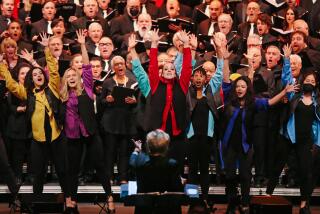ORANGE COUNTY VOICES PATRICK MOTT : Show of Independence From a Captive Audience
- Share via
The first place we stopped when we walked up the sloping road to Tallinn’s “old town,” the medieval walled city, was at a barricade. The boulders that had been pushed back toward the curbs were huge, most of them at least half the size of the buses in which we had arrived.
They had been there since February, our young guide explained, ever since the citizens of the Estonian capital city feared that the Soviet tanks that had recently rolled into the Lithuanian capital of Vilnius might turn north and advance on Tallinn.
So every approach to the old town, atop which sat the Estonian parliament building, had been blocked with boulders and immense prefabricated concrete blocks. Students and others had gathered in the square--often in spite of official warnings--in a show of defiance and in support of the Estonian independence movement.
Our young guide was one of them. Her voice had broken when she told us. And when she led us around the corner to the tall, ancient stone tower that flew the tricolor flag of Estonia, she pointed to it and wept. For the nationalistic Estonians, the sight of that flag, which recently replaced the hammer and sickle, was enough in itself to stir profound emotions.
We had not expected to see this. We were singers from Orange County, in Tallinn in late June to perform at an international music festival. So far, the members of the Pacific Chorale had busied themselves with rehearsals and exploring in the neighborhoods near our hotel, with the curious but offhand eye of the tourist. We had not yet realized where we were.
Neither was it easy to divine the attitudes and character of the people around us. Day to day, the Estonians tend to be taciturn and undemonstrative. They are far from unfriendly, but shows of emotion are not part of their nature.
But we learned that they had a passion that we did not, a fire in the belly that most Americans feel only occasionally, if at all. They loved their country absolutely, and freedom even more.
Theirs was not holiday patriotism. When they spoke of their country’s independence, their faces would set and their eyes would become resolute. They equated freedom with struggle and sacrifice. And, having never had it in their modern history, they knew exactly what freedom meant.
For Estonia--and the other Baltic States and, indeed, for all of the Soviet Union it means the pains of economic and social reorganization, the possible inequities of success for some and privation for others, the uncertainty of learning by doing, and the specter of initial failure.
For us, Americans from the cocoon of Orange County who had never felt the twin bolts of fear and resolve that surely must strike each soul behind a tank barricade, education came after our final two concerts in Estonia. We had obtained copies of the Estonian national hymn, “Hoia, Jumal, Eestit” (God Preserve Estonia) and sang it at the conclusion of each of the two programs.
Each time, the audience rose to its feet and the eyes of the stolid Estonians suddenly filled with tears. The last notes had died many seconds before the listeners could collect themselves and applaud. We had never seen such a reaction from an audience.
Now, at home and half a world away, when we think of the new life Estonia may make for itself--which now may be joyfully inevitable--it is those faces we see. And we would like to believe that we have kept some of that magnificent passion and hope for ourselves.
More to Read
Sign up for Essential California
The most important California stories and recommendations in your inbox every morning.
You may occasionally receive promotional content from the Los Angeles Times.













